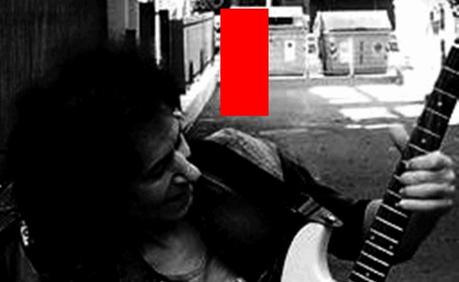INTRODUCTION:
(Here, original article: http://circlepicking.blogspot.it/)
Picks are usually gripped with two fingers—thumb and index—and are played with pointed end facing the strings. However, it’s a matter of personal preference and many notable musicians use different grips. For example, Eddie Van Halen holds the pick between his thumb and middle finger (leaving his first finger free for his tapping technique); James Hetfield, Jeff Hanneman and Steve Morse hold a pick using 3 fingers—thumb, middle and index; Pat Metheny and The Edge also hold their picks with three fingers but play using the rounded side of the plectrum. George Lynch also uses the rounded side of the pick. Stevie Ray Vaughan also played with the rounded edge of the pick, citing the fact that the edge allowed more string attack than the tip. His manic, aggressive picking style would wear through pickguards in short order, and wore a groove in his Fender Stratocaster, Number One, over his years of playing. Jimmy Rogers and Freddie King had a special kind of technique utilizing two picks at once. Noted 80’s session guitarist David Persons is known for using old credit cards, cut to the correct size, angle, and thickness and using them without a tip.
The motion of the pick against the string is also a personal choice. George Benson and Dave Mustaine, for example, hold the pick very stiffly between the thumb and index finger, locking the thumb joint and striking with the surface of the pick nearly parallel to the string, for a very positive, articulate, consistent tone. Other guitarists have developed a technique known as circle picking, where the thumb joint is bent on the downstroke, and straightened on the upstroke, causing the tip of the pick to move in a circular pattern, which can allow speed and fluidity. The angle of the pick against the string is also very personal and has a broad range of effects on tone and articulation. Many rock guitarists will use a flourish (called a pick slide or pick scrape) that involves scraping the pick along the length of a round wound string (a round wound string is a string with a coil of round wire wrapped around the outside, used for the heaviest three or four strings on a guitar).
The two chief approaches to fast picking are alternate picking and economy picking. Alternate picking is when the player strictly alternates each stroke between downstrokes and upstrokes, regardless of changing strings. In economy picking, the player will use the most economical stroke on each note. For example, if the first note is on the fifth string, and the next note is on the fourth string, the pick will use a downstroke on the fifth string, and continue in the same direction to execute a downstroke on the fourth string. Some guitarists learn economy picking intuitively and find it an effort to use alternate picking. Conversely, some guitarists maintain that the down-up “twitch” motion of alternate picking lends itself to momentum, and hence trumps economy picking at high speeds.
CIRCLE PICKING:
First off, by holding the pick between your thumb and index finger, draw a small imaginary circle (about 1/3″ in diameter) with the tip of the pick. Make sure that you’re not moving your wrist, but just your thumb and finger…just like you were drawing the circle with a pen.
Next grab your guitar, choose a single string and start picking the string down and up in standard fashion by moving your wrist; floor to ceiling. As you’re picking down and up, start “drawing the circle” and you should notice that you’re now striking the string twice as many times as you were without the circle! Now practice on the other strings with scales etc., and add this to your bag of tricks!
You can also strum full chords using this technique by simply drawing a bigger circle. This gives you an almost harp like quality to your strum…very different sounding! You can hear Roy Buchanan himself using this technique on the song “Thank you Lord” on his album release “Roy Buchanan Second Album”.

Here Mimmo Parisi, Italian guitar player, in action